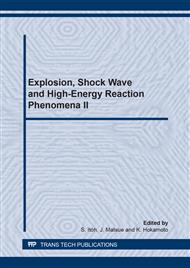p.132
p.138
p.144
p.150
p.154
p.160
p.166
p.171
p.177
Estimation of Crater in Reinforced Concrete Wall Caused by Mini-Blasting
Abstract:
The crack on the reinforced concrete wall generated by the explosion of several grams of Composition C4 explosive was investigated. A series of the single-shot blast experiment were conducted. The structural specimens for the reinforced concrete wall () were used for estimation of the crater size. The diameter of the borehole was fixed 16 mm, and the depth was varied to generate the various size of crater. The amount of explosive was also varied from 2.0 to 3.5 g. The effect of the depth of the borehole to the crater depth was examined, and the optimum charge condition for making the large crater at borehole side was clarified. For the case in which the fragmentation at the back side was allowed, the optimum charge condition was also found. High-speed photography was used to observe the growth process of the surface cracks. As the results, it was predicted that the crater was generated at 2 ms after explosion at least. The strain measurements were also conducted.
Info:
Periodical:
Pages:
154-159
Citation:
Online since:
July 2013
Keywords:
Price:
Сopyright:
© 2014 Trans Tech Publications Ltd. All Rights Reserved
Share:
Citation:


